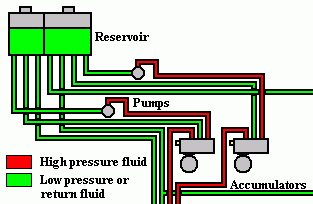The hydraulic system: |
|
|
|
The fluid pressure control: |
|
|
|
Introduction of the fluid pressure system

The diagram of the fluid pressure
From the reservoir the fluid flows to the pumps on top of the engine. These pumps are operated by the camshaft of the engine en build up the pressure of the fluid. The fluid under pressure flows to the accumulators. The pressure system is a dual system in order to possess a separate brake system.
Part of an accumulator is a sphere which is divided in two parts by a diaphragm. The lower compartment of the sphere is filled with pressurised nitrogen. The upper part is filled with brake fluid. Because the fluid is under pressure the membrane in the sphere is pushed downwards against the pressure of the nitrogen.
The upper part of an accumulator is the valve body. This consists of two valves that regulate the fluid pressure. The first valve is open when the fluid is pressurised. The valve closes when the right presuure is reached. The second valve is for safety purposes. This valves opens when the pressure of the fluid has become too high. In that case the fluid flows back to the reservoir. The accumulators manage that when the engine would cease to operate during driving the brake pedal can still be used another 50 times before the pressure has disappeared completely.
The system is filled with Castrol RR363 fluid. This fluid is specially developed for this system. It has lubricating abilities in order to keep running the moving parts. It is not allowed under any circumstances to replace the fluid by other fluids.
All cars from 1980 and cars from chassisnumber 50001 (1979) are provided with a system that needs mineral fluid. This system can be recognised by the green labels that are stuck on several hydraulic components. The two kinds of fluid may never be interchanged or mixed.
|
 Marinus Rijkers. Disclaimer
Marinus Rijkers. Disclaimer
 Marinus Rijkers. Disclaimer
Marinus Rijkers. Disclaimer